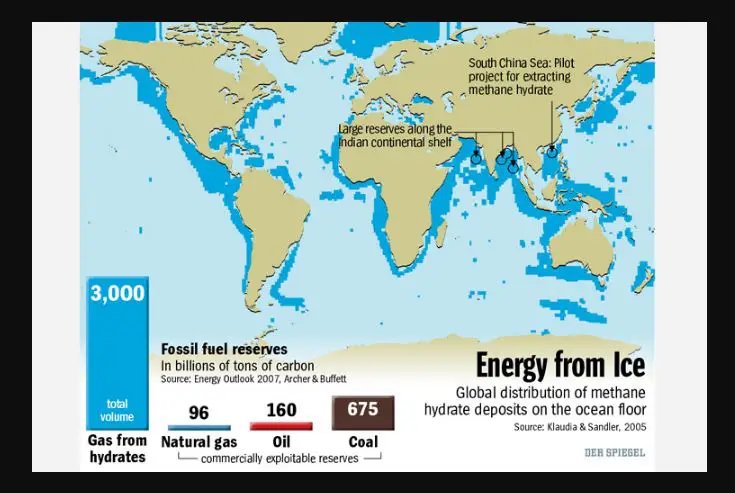Table of Contents
Natural Gas Hydrates in India | UPSC – IAS | Science and Tech
Researchers at Indian Institute of Technology (IIT) Madras have experimentally shown that methane and carbon dioxide (CO2) can exist as gas hydrates.
What are Gas hydrates? | UPSC – IAS | PCS
- They are formed when a gas such as methane gets trapped in well-defined cages of water molecules forming crystalline solids. It is a solid ice-like form of water that contains gas molecules in its molecular cavities.
- Natural gas hydrates occur on continental margins and shelves worldwide from Polar Regions to the tropics.
- Gas hydrate reservoirs are generally associated with biologically rich cold seep ecosystems at the seafloor. Cold seeps are locations where hydrocarbon-rich fluid seeps up from below the seafloor, often as methane or hydrogen sulfide.
- It is estimated that total amount of carbon in the form of methane hydrates, far exceeds the carbon content in all the fossil fuel reserves put together and hence these are supposed to be the future potential energy resource.
- Combustion of methane, is more CO2 efficient than that of any other hydrocarbon. Hence, using methane from gas hydrate compared to other hydrocarbons is relatively climate friendly.
- According to the latest estimates of the US Geological Survey, India has the second largest gas hydrate reserves after America. The Krishna-Godavari (KG), Cauvery and Kerala basins alone have 100-130 trillion cubic feet of estimated reserves.
- The carbon dioxide hydrate produced in the lab by the IIT team raises the possibility of sequestering or storing carbon dioxide as hydrates under the sea bed.
Extraction of Gas Hydrates: The natural gas from gas hydrate can be produced via:-
- Depressurization: Drilling of hole into the layer of hydrate and reducing the pressure beneath. This technique is implemented for hydrates only in polar regions beneath the permafrost.
- Thermal stimulation: via steam injection, hot brine solution etc. that raises the temperature of the local reservoir outside the hydrate region to cause the dissociation of the hydrate, thus releasing free gas which can be collected.
However, no country in the world has so far developed the technology to produce gas hydrates commercially and economically.
Issues with Gas Hydrates Extraction | UPSC – IAS
Gas hydrates are also important for seafloor stability studies, because “melting” gas hydrate may cause seafloor “landslides”. Methane released from gas hydrate may therefore play a significant role in climate change.
Indian Initiative| UPSC – IAS | PCS
- The National Gas Hydrate Programme (NGHP) is of national importance considering India’s phenomenal growing energy demand. The programme was initiated in 1997. It first conducted studies in 2006.
- India has entered into an agreement with Canada to develop technology in this regard.
- IIT Madras, in collaboration with GAIL, is working to recover methane from methane hydrate from the Krishna-Godavari Basin and sequester CO2 simultaneously.


